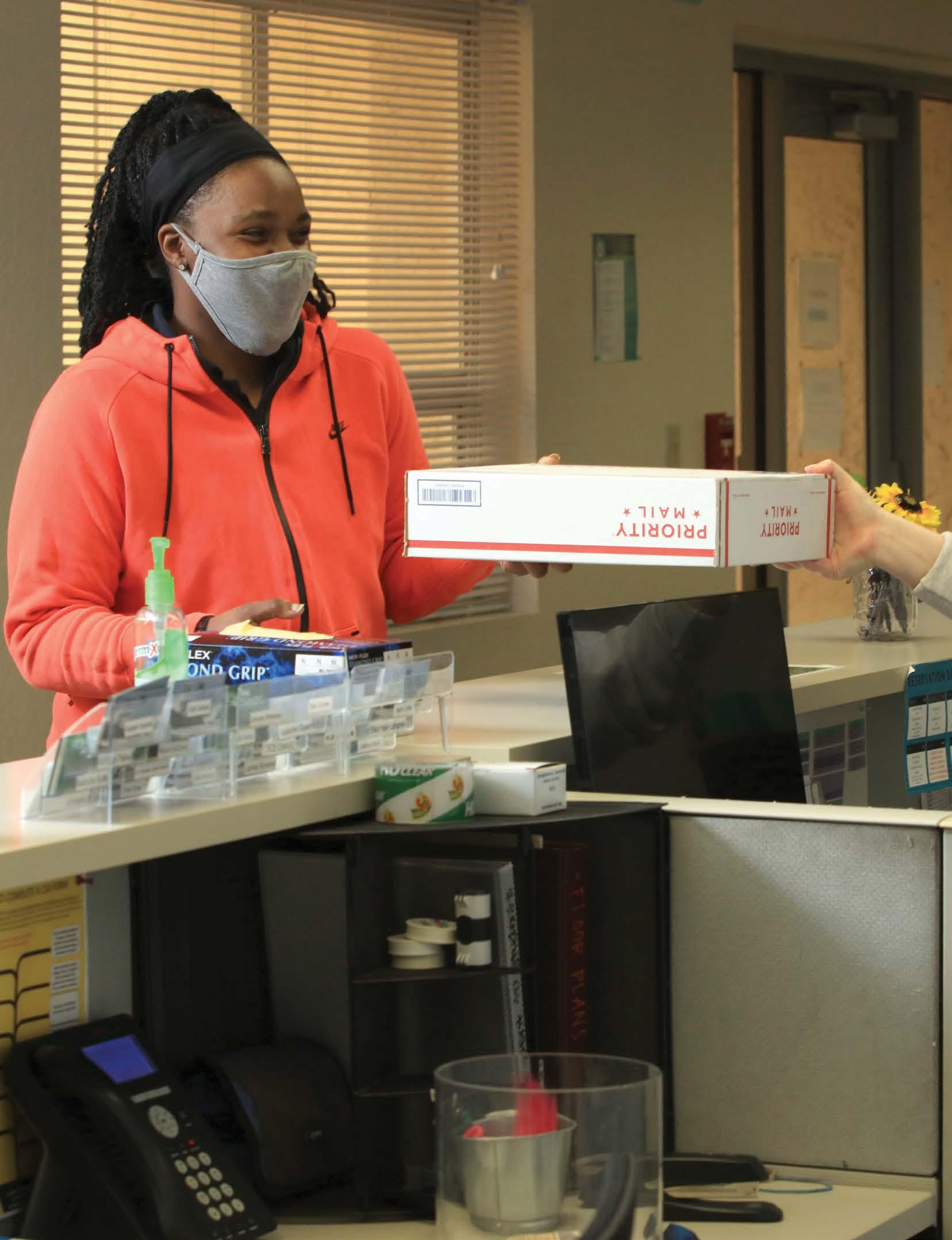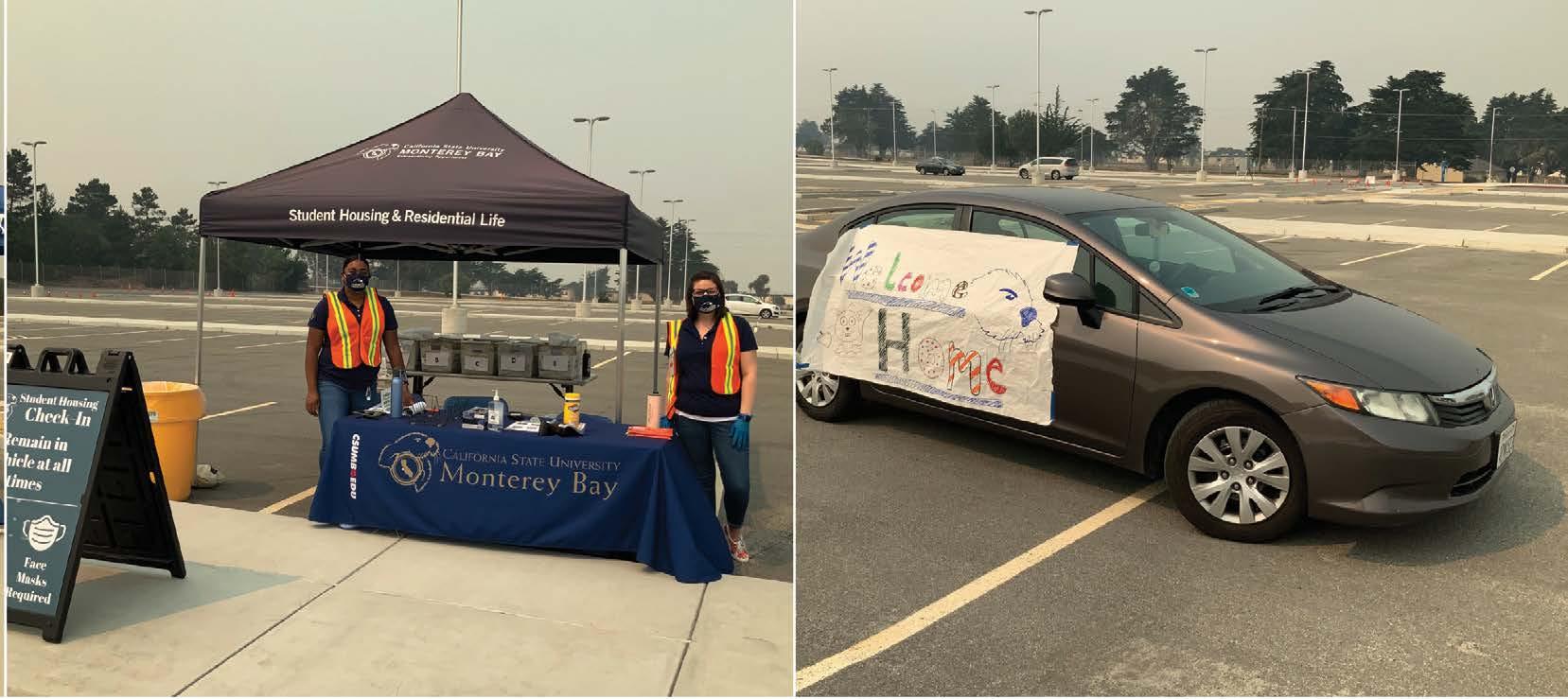
5 minute read
Magazine | Life on Campus Amid COVID-19
Life on Campus Amid COVID-19
Student Housing provides security, support for those with nowhere else to go
Advertisement
BY LIZ MACDONALD
When the CSU announced most instruction would be delivered remotely for the remainder of 2020 because of the COVID-19 pandemic, the majority of the roughly 3,600 CSUMB students who usually live on campus left. But a subset of the student population had no place else to go.

Kim McKinney, resident assistant, and Robyn DoCanto, coordinator of housing operations, are among the staff who remained on campus to serve students.
Photo by Randy Tunnell
Some lived in the family units available on East Campus with their young children. International students faced travel restrictions and were unable to return to their countries of origin. Others were former foster youth who counted on the campus to provide housing. Still others, just months away from earning their degrees, would have had their graduation jeopardized by losing their housing.
Fifteen percent of CSUMB students self-identify as housing insecure for a number of complex reasons. The university staff in the Department of Student Housing and Residential Life wanted to make sure that those students had access to safe and secure housing.

Student Housing and Residential Life staff welcome students to campus in August during housing check-in. Approximately 350 students were able to live on campus in Fall 2020.
Photos by Sydney Clemann
“Even in the most dire situations, we have to find a way to support those students,” Director Jeff Cooper said. “It was important that we stay open, but we had to figure out how to do that and maintain safety.”
Finding a Way
As students who could moved off campus, the university began to consolidate the locations where the roughly 1,000 students who remained on campus were housed. They brought students into the residence halls on Main Campus and to the Frederick Park apartment-style housing on East Campus.
“We had to make a lot of fast decisions with information about the pandemic changing daily,” Cooper said. “Our first priority was keeping our live-in staff — our resident advisors and Residential Life coordinators — protected so they could continue their work with PPE [Personal Protective Equipment] and physical distance.”
The team followed Centers for Disease Control and Prevention protocols while also trying to accommodate student needs. For instance, WiFi is provided on Main Campus, but those moved to East Campus would have had to purchase their own routers for nearly $100. With all instruction online, living without internet access wasn’t an option. So Cooper’s team purchased a dozen routers and made them available for students to check out.
Over the summer, about 250 students remained on campus. For fall semester, the number of students was about 350. Almost everyone was assigned (one student per apartment) to individual units on East Campus, and supported by a skeleton crew of nine resident advisors.
“We’re still here trying to create a community and serve the students on campus,” said Shanae Vaifanua, the associate director of Residential Life, who oversees the live-in staff. “Our team rallied together, moved and shifted as the waves came. We’re all here because we want to help meet the needs of students who have no safe place to go elsewhere.”
Riding the Waves
There have been a lot of waves to contend with: the global pandemic and the shelter-in-place order; the transition to complete distance learning; the Black Lives Matter movement taking to the streets; and record wildfires all across California and the western U.S., including three in Monterey County. Smoke was so thick the sky turned an eerie red and air quality bordered on hazardous.
“Our mission is to provide a sense of connectedness and belonging,” Cooper said. “We’ve doubled our efforts to find new ways to engage so that students know we’re here for them.”
“Our job is still to help the students grow and develop as young adults,” added Vaifanua. Her team puts together weekly digital programs to help the students connect with one another and explore topics such as academic success, financial wellness, conflict management and self-care.
“We’re really focused on mental health,” she said. “We’re doing daily Zoom office hours and individual check-ins with students. Our [resident advisors] are rock stars.”

Student Housing and Residential Life staff welcome students to campus in August during housing check-in. Approximately 350 students were able to live on campus in Fall 2020.
Photos by Sydney Clemann
Above and Beyond
Amy Zamara has been a resident advisor (RA) for four years. A non-traditional student, she transferred to CSUMB and lives in family housing on East Campus with her daughter. On top of homeschooling her 11-year-old, she’s currently pursuing her master’s degree in social work, working as an intern for a student support team at UC Santa Cruz, and because of staffing cuts and her seniority as an RA, supporting the students who live on her street and a second street. The usual assignment is one street per RA.
“I’ve definitely been asked to do more this year,” she said. “I’m willing to do it. The need from students is greater. At the same time, I’m grateful to have this role. It’s the only way I can afford to be here and attend grad school.”
In addition to helping students with the usual issues of residential life, Zamara is helping her peers navigate loneliness and disconnection. Normally a first-year student would be living with roommates, walking down shared hallways, cooking in common kitchens and attending classes and events in person. Now, there are 18-year-olds on their own for the first time, living alone and doing all their schoolwork and socializing online.
Because she’s studying to be a social worker, Zamara brings that perspective to her work as an RA. She pays attention to the student who consistently emails her about little things, an indicator they may be struggling with a larger issue — such as food insecurity — and works to find that student extra support.
Long Days and Hard Work
“There’s an added level of stress. But as a student staff member, I’m in a unique position to understand their needs,” she said. “I understand what it is like to have all your classes online. I know what it feels like to be stuck. I can help them know they aren’t alone in the struggle, and I play an important role to get their voices and concerns heard further up the ladder.”
“Our student leaders are so resilient and have such a commitment to service and leadership,” Vaifanua said. “People talk about unprecedented times, and it is definitely that for us. It’s been a lot of long days and a lot of hard work.”
The level of care and commitment from the staff is evident as they navigate a constantly shifting landscape. The CSU announced in September that Spring 2021 will also be entirely online. Students continue to find themselves homeless and reach out for help.
“I’ve got a good team working with me,” Cooper said. “We have to hold on to that strength to continue to support our students and their educational experience.” MB

